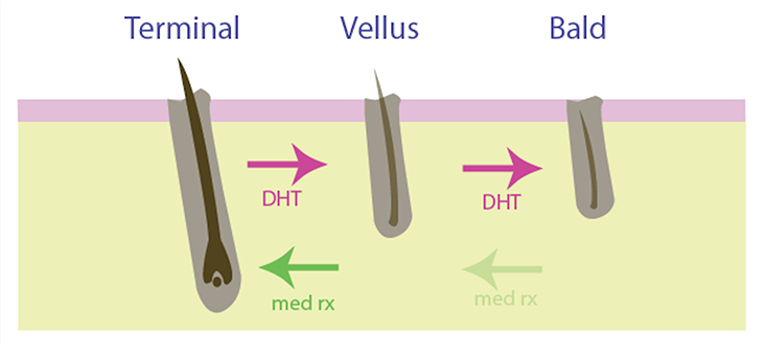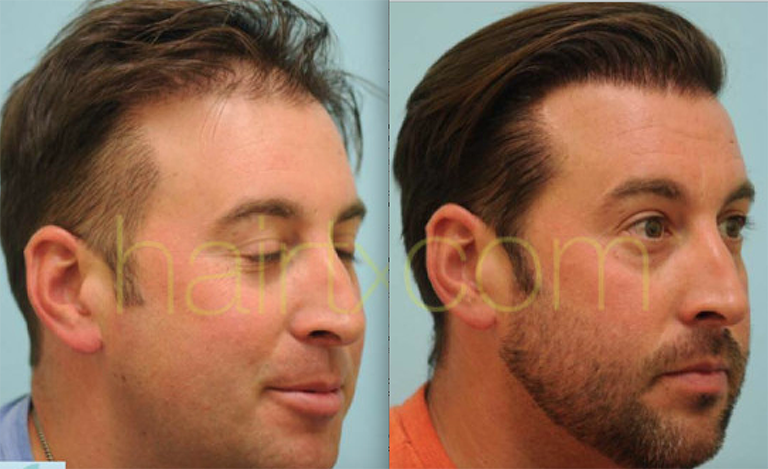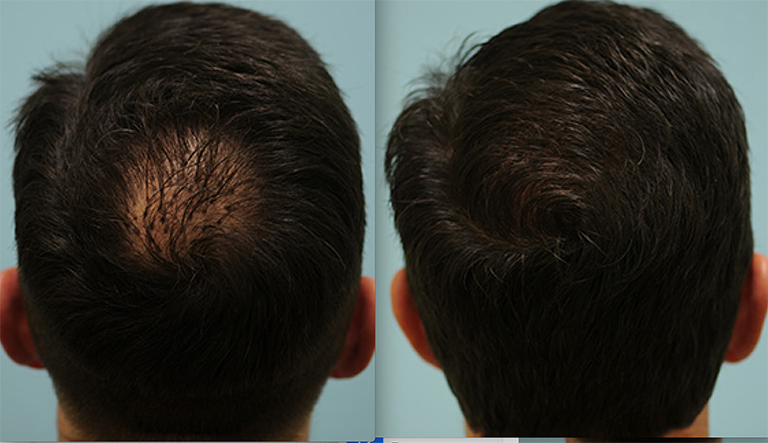Male Hair Transplant & Hair Restoration
Male hair loss, or male-pattern baldness, can affect men from the onset of puberty and thereafter but may also start later in life, with a prevalence of 80% of men by age of 80 experiencing some level of hair loss.
Contact Us Today! Read Our Manifesto Visit Our Gallery
Male Hair Loss

Male-pattern hair loss describes the changes from thick “terminal” hairs to thin “vellus” hairs that ultimately lead to complete baldness. Medications can help in part reverse the effects of dihydrotestosterone (DHT) on the hair-loss process.
Male hair loss occurs when hairs sensitive to the effects of a hormone known as dihydrotestosterone (DHT), which is converted from testosterone, begin to undergo thinning and become progressively smaller, shorter, and more transparent. This process of hair loss is known as miniaturization when thick “terminal” hairs of youth are slowly transformed into these thinner “vellus” hairs, which then in turn are lost and the man becomes progressively balder. Male hair loss usually follows distinct patterns described by the Norwood Hair Loss classification, and a primary goal when surgically restoring hair is to mimic these patterns so that the result will appear completely natural. There are two primary categories of treating male hair loss, non-surgically and surgically, and oftentimes combining both non-surgical and surgical options can yield better outcomes.
Non-Surgical Options

This gentleman had side effects from Propecia and he is shown before and 5 months after starting topical finasteride, known as 82F, with significant improvement and without return of side effects.
Today, more than ever, there are so many ways to improve male hair loss non-surgically. The two traditional ways of treatment are oral finasteride (marketed as Propecia) and topical minoxidil (marketed as Rogaine), together the medications work more effectively than either one alone. However, today there are so many ways to deliver these two medications based on compliance, budget, side effect risks, etc. Dr. Lam today prefers to start with a Hair Genome Test in which a simple buccal swab in your mouth will generate very specific dosing of your medical therapy that is tailored to your precise genetic profile. Results of the test are usually back in 3 to 4 weeks with 14 genetic parameters evaluated for optimal dosing and minimization of any side effects. Dr. Lam tries to combine oral therapies, for example, oral finasteride and oral minoxidil, or topical therapies like topical finasteride and topical minoxidil. The benefit of an oral regimen is easier compliance, whereas the benefit of a topical therapy will be minimization of absorption in the body for risk of side effects. By using the Hair Genome results, he can specifically compound the precise dosing that your body needs. For those who prefer to start simply with an empiric standard dose, he can do that with either the oral or the topical formulation. For example, a standard formulation of topical finasteride and minoxidil that has worked well for his patients over the years is 82F.
Although Dr. Lam believes that daily therapy should be considered the best way to combat male pattern hair loss, there are other methods that can serve as a complement or replacement for daily therapy, including the following:
- Hair Stem: This revolutionary new treatment now offers a new, improved method of Platelet-Rich Plasma (PRP) injections. Rather than using needles, this treatment is completely needle-free and pain free and uses much higher levels of plant-based, bioidentical growth factors. It is performed once a month for 3 months and then maintained every 6 months.
- Folliflo: This product took Dr. Lam 2 years to create and is a plant-based, all-natural therapy to help with hair shedding and hair loss to strengthen hair with a simple spray a day.
- Low-Level Laser Therapy – wearing this laser cap 3 times a week for 20 to 30 minutes each time can significantly improve, reverse, and slow down hair loss.
There can be other non-surgical methods that can help too. SL Max is a topical baldness camouflage product that when sprinkled on the head can provide an instantaneous full head of hair. To cover scars or areas of baldness, a semi-permanent tattoo, known as scalp micropigmentation, can be applied to the scalp by our artistic team.
Dallas hair transplant surgeon Dr. Sam Lam, winner of the 2022 ISHRS Golden Follicle Award, offers diverse methods to restore lost hair for the male patient including scalp FUE, beard FUE, scalp FUT, scalp micropigmentation (SMP), advanced medical therapies, all performed painlessly in his state-of-the-art Joint Commission accredited surgical facility in Plano, Texas, just north of Dallas.
 Lam Institute For Hair Restoration
Lam Institute For Hair RestorationSurgical Options

This 36-year-old gentleman had two prior unsuccessful hair transplant surgeries performed elsewhere with poor visual density, a grafty/pluggy and unnatural hairline, and lack of balance in his temple hair region. He is shown seven months following a single megasession hair transplant corrective procedure with Dr. Lam with extensive temporal point, hairline, central forelock and midscalp hair restoration.
When areas of the scalp have become bald or significantly thin, medical therapy typically does not work very effectively. Hair transplant surgery is then the preferred option if the person is an appropriate candidate. There are many factors that can affect Dr. Lam’s decision whether surgery would be right for you. For example, a very young patient with rapidly thinning hair may lose enough hair in the future that there would not be sufficient donor hair to be used to cover the progressive hair loss. In such cases, among other factors, Dr. Lam may decide surgery is not a safe or viable option for you. That is why a consultation is so important.
There are many ways to perform hair transplant surgery today, and Dr. Lam practices the full gamut of procedures. It is important that you come in for consultation to help discuss with you what may be the better option for you. We invite you to explore each of the procedure pages below to understand the pros, cons, and limitations of each method. Ultimately, a consultation is the only way to determine what method would work best for you. Here are the three major methods of hair transplant surgery:
- FUE (and robotic FUE surgery – FUE stands for Follicular Unit Excision and involves removing individual hair follicles using a rotary punch device, whether by hand or by robot. This method can be used to harvest hairs from the scalp, beard, and body for transplantation elsewhere. The main advantage of this procedure is that a short hairstyle can be worn without showing any scar.
- FUT surgery – FUT stands for Follicular Unit Transplantation and involves a linear incision in the back of the head to harvest hair follicles. Despite popular belief today, this method is still an amazing procedure with very limited scarring, as seen in Dr. Lam’s many video close-up results. The main advantage of this technique is that it is very effective to perform a megasession procedure to cover extensive baldness in a single session.
- FUE-FUT surgery – This combined technique of using FUE and FUT surgery simultaneously offers the advantages of both methods and is oftentimes used to optimize ability to harvest hairs in a single session, e.g., using beard FUE hairs and scalp FUT hairs. Further details and examples can be found on the FUE-FUT procedure page
Specialized Surgical Topics

This 49-year-old male who had plugs placed in his crown in a previous procedure done elsewhere is shown one year following a crown revision procedure using FUE/ARTAS.
This website contains thousands of pages, before-and-after photos, and videos to help you understand what makes us different. Dr. Lam has extensive experience with all types of ethnic hair transplants, corrective hair transplants, scar repairs, eyebrow hair transplants, eyelash hair transplants, facial hair transplants, body hair transplants, and hair transplants to help a man transition out of a hairpiece or hair system. We invite you to take your time to explore this website in-depth to be better educated about the services that we have to offer you. We look forward to meeting you in person to discuss your particular issue with hair loss and to explore what we could do to restore your lost hair!
For more information, please watch our videos on Male Hair Transplant & Hair Restoration
Please click here for our Before and After Photos.




